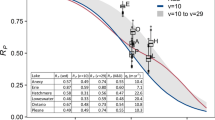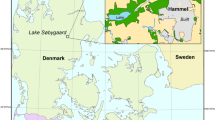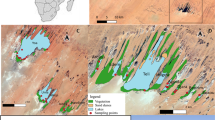Abstract
Diatom-based transfer functions for inferring epilimnetic total phosphorus (TP) have been developed from a data set of 33 southeastern Australian water storages. Regular institutional monitoring of these sites has allowed comparison of models developed from TP data covering different time periods. A model based on mean annual TP performs better than models derived from winter maximum TP, spring minimum TP or TP nearest the time of diatom sampling. A mean annual TP model (WA-PLS 2 component) has a jack-knifed diatom-inferred versus measured TP correlation coefficient (r 2 jack) of 0.69 and a root-mean-square-error of prediction (RMSEP) of 0.246 log10μg TP l−1, while alternative models have RMSEP > 0.27. Deletion of two samples with uncharacteristic species composition and environmental conditions improved performance of the mean annual TP model (r 2 jack= 0.74; RMSEP = 0.233 log10μg TP l−1). Comparison with other published diatom-TP calibration models indicates that this model performs relatively well, with possible contributing factors including the extensive characterisation of TP (with an average 15 determinations making up the annual mean) and the dominance of planktonic diatoms in most sites. Downcore application of the model will allow the reconstruction of reservoir nutrient histories since commissioning, and thus provide a basis for understanding and management of reservoirs.
Similar content being viewed by others
References
Agbeti M.D. 1992. Relationship between diatom assemblages and trophic variables: comparison of old and new approaches. Can. J. Fish. Aquat. Sci. 49: 1171–1175.
American Public Heath Association, American Water Works Associated and Water Environment Federation (APHA), 1992. Standard methods for the examination of water and wastewater. American Public Heath Association, Washington.
Anderson N.J. 1997a.Historical changes in epilimnetic phosphorus concentrations in six rural lakes in Northern Ireland. Freshwat. Biol. 38: 427–440.
Anderson N.J. 1997. Reconstructing historical phosphorus concentrations in rural lakes using diatom models. In: Tunney H., Carton O.C., Brookes P.C. and Johnston A.E. (eds), Phosphorus Loss From Soil to Water, CAB International, Wallingford, pp. 95–118.
Anderson N.J. and Odgaard B.V. 1994. Recent palaeolimnology of three shallow Danish lakes. Hydrobiologia 275/276: 411–422.
Anderson N.J. and Rippey B. 1994. Monitoring lake recovery from point-source eutrophication: the use of diatom-inferred epilimnetic total phosphorus and sediment chemistry. Freshwat. Biol. 32: 625–639.
Anderson N.J., Rippey B. and Gibson C.E. 1993. A comparison of sedimentary and diatom-inferred phosphorus profiles: implications for defining pre-disturbance nutrient conditions. Hydrobiologia 253: 357–366.
Battarbee R.W., Jones V.J., Flower R.J., Cameron N.G., Bennion H., Carvalho L. and Juggins S. 2001. Diatoms. In: Stoermer E.F., Birks H.J.B. and Last W.M. (eds), Tracking Environmental Change Using Lake Sediments, vol. 3, Terrestrial, Algal and Siliceous Indicators. Kluwer Academic Publishers, Dordrecht, The Netherlands, pp. 155–202.
Bennion H. 1993. A diatom-phosphorus transfer function for eutrophic ponds in southeast England. Unpublished PhD thesis, University College London, 433 pp.
Bennion H. 1994. A diatom-phosphorus transfer function for shallow, eutrophic ponds in southeast England. Hydrobiologia 275/276: 391–410.
Bennion H. 1995. Surface-sediment diatom assemblages in shallow, artificial, enriched ponds, and implications for reconstructing trophic status. Diatom Res. 10: 1–19.
Bennion H., Wunsam S. and Schmidt R. 1995. The validation of a diatom-phosphorus transfer function: an example from Mondsee, Austria. Freshwat. Biol. 34: 271–283.
Bennion H., Allott T.E.H., Monteith D.T., Duigan C.A., Haworth E.Y., Anderson N.J. and Juggins S. 1996a. The Anglesey lakes, Wales, UK: changes in trophic status of three standing waters as inferred from diatom transfer functions and their implications for conservation. Aquat. Conserv. Mar. Freshwat. Ecosyst. 6: 81–92.
Bennion H., Juggins S. and Anderson N.J. 1996b. Predicting epilimnetic phosphorus concentrations using an improved diatom-based transfer function and its application to lake management. Environ. Sci. Technol. 30: 2004–2007.
Bennion H., Appleby P.G. and Phillips G.L. 2001. Reconstructing nutrient histories in the Norfolk Broads, UK: implications for the role of diatom-total phosphorus transfer functions in shallow lakes management. J. Paleolim. 26: 181–204.
Birks H.J.B. 1998. Numerical tools in palaeolimnology —Progress, potentialities, and problems. J. Paleolim. 20: 307–332.
Borcard D., Legendre P. and Drapeau P. 1992. Partialling out the spatial component of ecological variation. Ecology 73: 1045–1055.
Bormans M. and Webster I.T. 1999. Modelling the spatial and temporal variability of diatoms in the River Murray. J. Plankton Res. 21: 581–598.
Bowling L. 1994. Occurrence and possible causes of a severe cyanobacterial bloom in Lake Cargelligo, New South Wales. Aust. J. Mar. Freshwat. Res. 45: 737–745.
Bradshaw E.G. and Anderson N.J. 2001. Validation of a diatom-phosphorus calibration set for Sweden. Freshwat. Biol. 46: 1035–1048.
Bradshaw E.G., Anderson N.J., Jensen J.P. and Jeppesen E. 2002. Phosphorus dynamics in Danish lakes and the implications for diatom ecology and palaeoecology. Freshwat. Biol. 47: 1963–1975.
Cullen P. 1986. Managing nutrients in aquatic systems: the eutrophication problem. In: Williams W.D. and De Deckker P. (eds), Limnology in Australia, CSIRO, Melbourne, pp. 539–554.
Cullen P. 1993. Toxic algal blooms and the rhetoric of sustainability. Wetlands (Aust.) 12: 16–22.
Dixit S.S. and Smol J.P. 1994. Diatoms as indicators in the Environmental Monitoring and Assessment Program-Surface Waters (EMAP-SW). Environ. Monit. Assoc. 31: 275–276.
Dixit S.S., Smol J.P., Charles D.F., Hughes R.M., Paulsen S.G. and Collins G.B. 1999. Assessing water quality changes in the lakes of the northeastern United States using sediment diatoms. Can. J. Fish. Aquat. Sci. 56: 131–152.
Ferris J.M. and Tyler P.A. 1985. Chlorophyll-total phosphorus relationships in Lake Burragorang, New South Wales, and some other southern hemisphere lakes. Aust. J. Mar. Freshwat. Res. 36: 157–168.
Fritz S.C., Kingston J.C. and Engstrom D.R. 1993. Quantitative trophic reconstruction from sedimentary diatom assemblages: a cautionary tale. Freshwat. Biol. 30: 1–23.
Gasse F., Juggins S. and BenKhelifa L. 1995. Diatom-based transfer functions for inferring past hydrochemical characteristics of African lakes. Palaeogeogr. Palaeoclim. Palaeoecol. 117: 31–54.
Gibson C.E., Foy R.H. and Bailey-Watts A.E. 1996. An Analysis of the Total Phosphorus Cycle in Some Temperate Lakes — the Response to Enrichment. Freshwat. Biol. 35: 525–532.
Håkansson H., Olsson S., Jiang H. and Garbe-Schönberg C.D. 1998. The sediment diatom association and chemistry of surface sediments of Lake Belauer See, northern Germany. Diatom Res. 13: 63–91.
Hall R.I. and Smol J.P. 1992. A weighted averaging regression and calibration model for inferring total phosphorous concentration from diatoms in British Columbia (Canada) lakes. Freshwat. Biol. 27: 417–434.
Hall R.I. and Smol J.P. 1999. Diatoms as indicators of lake eutrophication. In: Stoermer E.F. and Smol J.P. (eds), The Diatoms: Applications for the Environmental and Earth Sciences. Cambridge University Press, Cambridge, pp. 128–168.
Hall R.I., Leavitt P.R., Dixit A.S., Quinlan R. and Smol J.P. 1999. Limnological succession in reservoirs: A paleolimnological comparison of two methods of reservoir formation. Can. J. Fish. Aquat. Sci. 56: 1109–1121.
Harris G.P. 2001. Biogeochemistry of nitrogen and phosphorus in Australian catchments, rivers and estuaries: effects of land use and flow regulation and comparisons with global patterns. Mar. Freshwat. Res. 52: 139–149.
Harris G.P. and Baxter G. 1996. Interannual variability in phytoplankton biomass and species composition in North Pine Dam, Brisbane. Freshwat. Biol. 35: 545–560.
Hill M.O. 1973. Diversity and evenness: a unifying notation and its consequences. Ecology 54: 427–432.
Holland J. and Clark R.L. 1989. Diatoms of Burrinjuck Reservoir, New South Wales, Australia. CSIRO Division of Water Resources Divisional Report 89/1: 1–79.
Hötzel G. and Croome R. 1996. Population dynamics of Aulacoseira granulata (Ehr.) Simonson (Bacillariophyceae, Centrales), the dominant alga in the Murray River, Australia. Arch. Hydrobiol. 136: 191–215.
Jeffcoat K. 1996. Major rural dams in New South Wales. New South Wales Department of Land and Water Conservation, Parramatta, 59 pp.
Jones V.J. and Juggins S. 1995. The construction of a diatom-based chlorophyll a transfer function and its application at three lakes on Signy Island (maritime Antarctic) subject to differing degrees of nutrient enrichment. Freshwat. Biol. 34: 433–445.
Juggins S. and ter Braak C.J.F. 1997. CALIBRATE Version 0.8. Unpublished Computer Program, University of Newcastle.
Kauppila T., Moisio T. and Salonen V.-P. 2002. A diatom-based inference model for autumn epilimnetic total phosphorus concentration and its application to a presently eutrophic boreal lake. J. Paleolim. 27: 261–273.
Krammer K. and Lange-Bertalot H. 1986. Bacillariophyceae. 1: Teil: Naviculaceae. Gustav Fischer, Jena, 876 pp.
Krammer K. and Lange-Bertalot H. 1988. Bacillariophyceae. 2: Teil: Bacillariaceae, Epthimiaceae, Surirellaceae. Gustav Fischer, Jena, 576 pp.
Krammer K. and Lange-Bertalot H. 1991. Bacillariophyceae. 3: Centrales, Fragilariaceae, Eunotiaceae. Gustav Fischer, Stuttgart, 576 pp.
Krammer K. and Lange-Bertalot H. 1991. Bacillariophyceae. 4: Achnanthes, Kritische Ergänzunhen zu Navicula (Lineolatae) und Gomphonema Gesamtliteraturverzeichnis Teil 1-4. Gustav Fischer, Stuttgart, 437 pp.
Lange-Bertalot H. and Krammer K. 1989. Achnanthes eine Monographie der Gattung. Cramer, Berlin, 393 pp.
Lawrence I., Bormans M., Oliver R., Ransom G., Sherman B., Ford P. and Wasson B. 2000. Physical factors controlling algal succession and biomass in Burrinjuck Reservoir. Cooperative Research Centre for Freshwater Ecology, Canberra, 133 pp.
Lidston J. 1993. Victorian Water Quality Network Lakes Program. Pilot Study. State Water Laboratory, Armadale, Victoria, Australia.
Lotter A.F., Birks H.J.B., Hofmann W. and Marchetto A. 1998. Modern diatom, cladocera, chironomid, and chrysophyte cyst assemblages as quantitative indicators for the reconstruction of past environmental conditions in the Alps. II. Nutrients. J. Paleolim. 19: 443–463.
Matveev V. and Matveeva L. 1997. Grazer control and nutrient limitation of phytoplankton in two Australian reservoirs. Freshwat. Biol. 38: 49–65.
McLennan W. 1996. Australians and the Environment. Australian Government Publishing Service, Canberra, 415 pp.
Olley J.M. and Caitcheon G.G. 2000. The major element chemistry of sediments from the Darling-Barwon River and its tributaries: Implications for sediment and phosphorus sources. Hydrol. Proc. 14: 1159–1175.
Philibert A. and Prairie Y.T. 2002. Is the introduction of benthic species necessary for open-water chemical reconstructions in diatom-based transfer functions? Can. J. Fish. Aquat. Sci. 59: 938–951.
Reavie E.D. and Smol J.P. 2001. Diatom-environmental relationships in 64 alkaline southeastern Ontario (Canada) lakes: a diatom-based model for water quality reconstructions. J. Paleolim. 25: 25–42.
Reavie E.D., Hall R.I. and Smol J.P. 1995. An expanded weighted-averaging model for inferring past total phosphorus concentrations from diatom assemblages in eutrophic British Columbia (Canada) lakes. J. Paleolim. 14: 49–62.
Reed J.M. 1998. A diatom-conductivity transfer function for Spanish salt lakes. J. Paleolim. 19: 399–416.
Sandercock C. 1996. Major storages operational monitoring program report, 1992-1995. Waterecoscience, Mt. Waverley, Victoria, Australia.
Sayer C.D. 2001. Problems with the application of diatom-total phosphorus transfer functions: examples from a shallow English lake. Freshwat. Biol. 46: 743–757.
Smol J.P. 2002. Pollution of Lakes and Rivers: a Paleoenvironmental Perspective. Arnold, London, 280 pp.
ter Braak C.J.F. and Juggins S. 1993. Weighted averaging partial least squares regression (WA-PLS): an improved method for reconstructing environmental variables from species assemblages. Hydrobiologia 268/70: 485–502.
ter Braak C.J.F. and Šmilauer P. 1998. CANOCO Reference Manual and User's Guide to Canoco for Windows. Software for Canonical Community Ordination (version 4). Centre for Biometry, Wageningen.
Tibby J. 2000. The development of a diatom-based model for inferring total phosphorus and application to Burrinjuck Reservoir, southern New South Wales, Australia. Unpublished PhD thesis, School of Geography and Environmental Science, Monash University.
Tibby J. 2001. Diatoms as indicators of sedimentary processes in Burrinjuck reservoir, New South Wales, Australia. Quat. Int. 83-85: 245–256.
Tibby J., Rerd M., Fluin J., Hart B.T. and Kershaw A.P. 2003. Assessing long-term pH change in an Australian river catchment using monitoring and palaeolimnological data. Environ. Sci. Technol. 37: 3250–3255.
Watts C.J. 2000. The effect of organic matter on sedimentary phosphorus release in an Australian reservoir. Hydrobiologia 431: 13–25.
Wright H.H. 1990. An improved Hongve sampler for surface sediments. J. Paleolim. 4: 91–92.
Wunsam S. and Schmidt R. 1995. A diatom-phosphorus transfer function for Alpine and pre-alpine lakes. Mem. Ist. Ital. Idrobiol 53: 85–99.
Author information
Authors and Affiliations
Rights and permissions
About this article
Cite this article
Tibby, J. Development of a diatom-based model for inferring total phosphorus in southeastern Australian water storages. Journal of Paleolimnology 31, 23–36 (2004). https://doi.org/10.1023/B:JOPL.0000013272.25122.2a
Issue Date:
DOI: https://doi.org/10.1023/B:JOPL.0000013272.25122.2a




